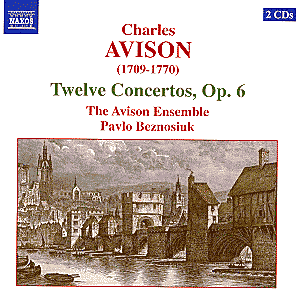The English composer
Charles Avison was a remarkable individual
in several ways. He was born in 1709
in Newcastle-upon-Tyne, close to the
Scottish border, where he received his
first musical training by his father,
who was one of the city waits. Although
he went to London in 1724 to broaden
his musical horizon, he returned to
Newcastle in 1735, where he stayed until
his death in 1770. In doing so he lived
and worked outside the mainstream of
English musical life in the decades
around 1750.
But he was also remarkable
in his musical ideas. During his stay
in London he met the Italian violin
virtuoso and composer Francesco Geminiani,
who had a lifelong influence on Avison.
He developed a strong preference for
Italian music. This influence shines
through in the Concertos opus 6 recorded
here. He also admired the keyboard sonatas
of Domenico Scarlatti, and arranged
a number of them for strings and basso
continuo. His preference for the Italian
style went so far that, in 'An Essay
on Musical Expression' from 1752, he
claimed Geminiani was a greater composer
than Handel, which caused a vivid debate.
In a time when composers like Stanley,
Boyce and Arne were strongly influenced
by the style of Handel in their orchestral
compositions, there is no hint of Handel
in the concertos on this disc.
In his treatise of
1752 Avison also stated that in composition
expression is more important than formal
rules. The importance of musical expression
is clearly demonstrated in Op. 6. In
particular the slow movements excel
in this respect. An example of a fast
movement full of emotion is the 'allegro
con affetto' from the Concerto No. 7.
A notable feature of
this opus is that we experience here
the shift from the style of the baroque
towards the early classical style. While
eight of the twelve concertos from opus
6 are reworkings of those earlier published
as opus 2 (1740), for the publication
of this collection, Avison added four
new compositions. In their case he makes
use of the sonata form in most movements.
Several movements have attractive subjects
and this underlines another feature
of Avison's compositional style: his
attention to melody.
Avison may have been
influenced by the Italian style, one
shouldn't expect very dramatic music
here. He is very English, after all,
and these concertos are rather intimate
in comparison with the exuberance of
the compositions of Geminiani, Veracini
and the other Italians Avison so greatly
admired. The interpretation of the Avison
Ensemble does this music full justice.
The sound is perhaps less brilliant
than that of other orchestras, but it
fits the character of Avison's music
very well. Only in some movements I
thought the playing was slightly too
reserved, and the 'vivace' of the second
concerto could have been played with
more verve. Members of the orchestra,
in particular Pavlo Beznosiuk, play
the 'concertino' admirably.
To sum up: this is
a very fine recording of a quite interesting
opus by a composer who has more to offer
than simply arrangements of Scarlatti's
keyboard sonatas.
Johan van Veen
see also review
by Jonathan Woolf







